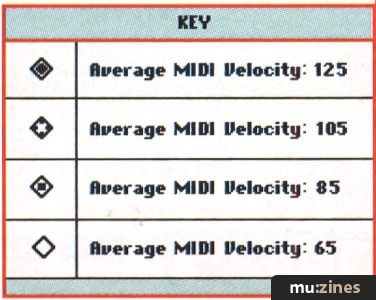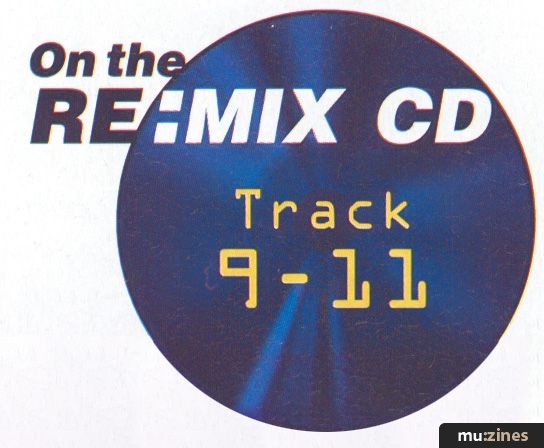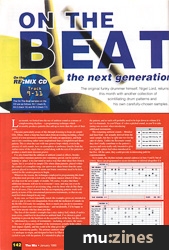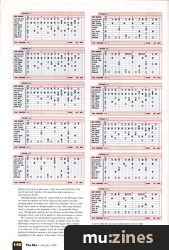Magazine Archive
Home -> Magazines -> Issues -> Articles in this issue -> View
Article Group: | |
On the beat (Part 4) | |
the next generationArticle from The Mix, January 1995 | |
Programming drums
The original funky drummer himself, Nigel Lord, returns this month with another collection of scintillating drum patterns and his own carefully-chosen samples...

Last month, we looked into the use of ambient sound as a means of complementing rhythms — a programming technique which invariably produces patterns that add up to more than the sum of their parts.
I became particularly aware of this through listening to loops on sample CDs. Often, where a loop has been taken from an existing recording, a brief snatch of a non-percussive instrument will make an appearance, and help turn it into something rather more inspirational than a straightforward drum pattern. This is often the case with rare groove loops which, even in the absence of such sounds, have an atmosphere or ambience (maybe from the surface noise of the vinyl) that is cycled along with the rest of the pattern to produce a much more insistent groove.
I've also found that the addition of ambient sound or effects, besides turning rather mundane patterns into something special, can be useful in helping to 'place' it in your mind in such a way that other ideas flow from it. Again, this is revealed on sample CDs where drum patterns, placed within the context of a complete song, can spawn new ideas better than the same patterns played in isolation. It seems our brains sometimes need to be kick-started for the creative process to begin.
Whatever the reason, the techniques employed in programming this kind of rhythm track provide a rich vein of rhythmic interest which I'd like to develop over the next couple of months. Of course, I realise that these additional elements will not be to everyone's taste, and may not even be useable in the context of an existing song, even by those who do like them. But in all cases, I have ensured that the accompanying patterns work well purely in terms of the conventional percussion instruments, so that no-one need feel short changed in any way.
In any case, as I have repeatedly staled, the examples given are intended to act as a spur to your own imagination. Even with the inclusion of sounds on the Re:Mix CD ready for sampling, there is much you can do to customise patterns to meet your own requirements — and incidentally, I'd be happy to hear from anyone who has done just that.
The first of this month's examples has a nice snakey feel, which, if such a term exists, could best be described as ambient funk. I've chosen a gated handclap to provide the backbeat on the second beat of the bar, but this could be substituted by a variety of instruments — including, of course, the snare.
The use of gating on a number of the instruments actually helps soften their impact slightly, and this tends to be what gives the pattern its rather instant, meandering quality. The primary ambient sound — dubbed Resonator — is analogue in origin, and designed to have its filter cut-off frequency cycled in sync with the pattern. It's intended to play consistently throughout the pattern, and as such will probably need to be kept down in volume if it isn't to dominate. As you'll hear, it's also a pitched sound, so you'll to take tuning into account when introducing additional instruments.
The remaining ambient sounds — Metalise and Steel End — are actually derived from the same sample, but they're split into two for the sake of clarity. Unlike the Resonator sound, they don't really contribute to the pattern's success and were really only intended to give it a slightly spikier feel when introduced in bar five. All the same, they could provide in interesting path for experimentation.
As it stands, the rhythm includes natural cadences in bars 4 and 8, but of course, these can programmed to occur elsewhere or deleted altogether if it better suits the song.

(Click image for higher resolution version)

(Click image for higher resolution version)
Pattern two is intended for use in electro/techno applications where a little more rhythm interest is demanded than the usual minimalist 808 fare. As you'll hear, it's quite a busy little pattern with a syncopated cabasa (or shaker) offsetting the strict 4/4 normally associated with this kind of rhythm. If desired, the bass drum can be thinned out a little, or perhaps substituted for a slightly softer instrument if you're using the Re:Mix sounds.
Providing the ambient interest are the pitched Low and High Bleeps alternating throughout the pattern, and the Wah Growl which, like Resonater in Pattern 1, synchronises a filter cut-off cycle with triggering on the first beat of bars 5, 6, 7 and 8. You could, of course have it running for the entire pattern, or break it up into different chunks according to where in a song it is required.
The last of this month's examples is intended to illustrate that it is quite possible to program heavier rock patterns using sequencer and drum machines, and that the results can be every bit as exciting as the real thing — and usually a lot more original.
Relying on heavy drum and cymbal sounds with plenty of live feel, the pattern kicks along at quite pace, with some neat hi-hat fills at the end of each half, together with snare/bass drum cadences to punctuate the rhythm.
Although having a distinctly sequencerish feel, the Blowpipe sound sits inside the rhythm very nicely and gives the pattern a broader potential appeal, providing it isn't allowed to dominate. The Low and High China sounds are designed purely to add a little more rhythmic interest, emerging at the beginning of bar 1, but gradually ebbing away. Though quite optional, they do illustrate an interesting rhythmic technique which could well be applied to other instruments or sounds.
My comments last month about triggering long samples once again apply. Unlike percussive samples designed to play for their full length, irrespective of the length of the trigger, these samples will need to be triggered for their full length if the required effect is to be achieved. As the samples stand, the sounds are of the correct duration for patterns running at the tempos indicated. Change the length/pitch of the samples or the tempo of the patterns and you'll need to make the necessary adjustment to one or other.
Again, as last month, I'd advise you to get the patterns up and running so that you know how they should sound, then make any alterations and begin your own experimentation. And before you know it... I'll be back next month with another lot.

(Click image for higher resolution version)
On The RE:MIX CD

The On The Beat samples on the CD are as follows: Kit 1 (track 9), Kit 2 (track 10) and Kit 3 (track 11).
- On the Beat Kits
Series - "On The Beat - The Next Generation"
Read the next part in this series:
On the beat (Part 5)
(MX Feb 95)
All parts in this series:
Part 1 | Part 2 | Part 3 | Part 4 (Viewing) | Part 5 | Part 6 | Part 7 | Part 8 | Part 9
More with this topic
The Sounds Of Motown |
Beat Box |
Funky Stuff - Making Classic Funk |
Rhythm and Fuse |
Warren Cann's Electro-Drum Column (Part 1) |
 Drum Programming - A Series By Warren Cann (Part 1) |
Alesis D4 Drum Processing Tricks |
 Tuning Your Breakbeats |
We Can't Go On... (Part 1) |
Beat Box |
Beat Box |
Personalise Your Drum Machine Sounds - Masterclass - Drum Machines |
Browse by Topic:
Drum Programming
Publisher: The Mix - Music Maker Publications (UK), Future Publishing.
The current copyright owner/s of this content may differ from the originally published copyright notice.
More details on copyright ownership...
Sound Advice
Topic:
Drum Programming
Series:
On The Beat - The Next Generation
Part 1 | Part 2 | Part 3 | Part 4 (Viewing) | Part 5 | Part 6 | Part 7 | Part 8 | Part 9
No Javascript: Audio player is disabled
Re:Mix #7 Tracklisting:
09 On the Beat (kit 1) 10 On the Beat (kit 2) 11 On the Beat (kit 3)
This disk has been archived in full and disk images and further downloads are available at Archive.org - Re:Mix #7.
Feature by Nigel Lord
Help Support The Things You Love
mu:zines is the result of thousands of hours of effort, and will require many thousands more going forward to reach our goals of getting all this content online.
If you value this resource, you can support this project - it really helps!
Donations for September 2025
Issues donated this month: 0
New issues that have been donated or scanned for us this month.
Funds donated this month: £0.00
All donations and support are gratefully appreciated - thank you.
Magazines Needed - Can You Help?
Do you have any of these magazine issues?
If so, and you can donate, lend or scan them to help complete our archive, please get in touch via the Contribute page - thanks!

















